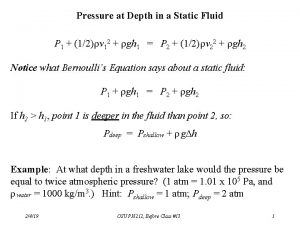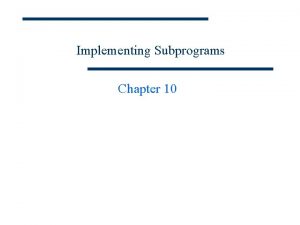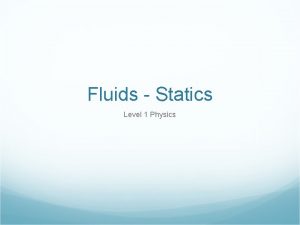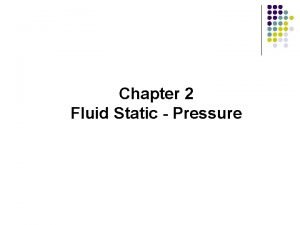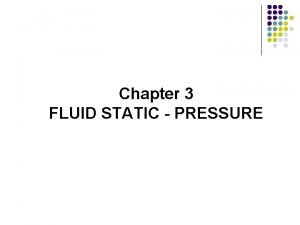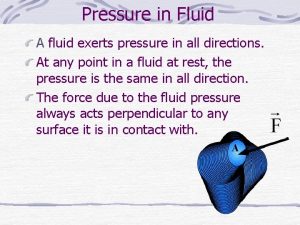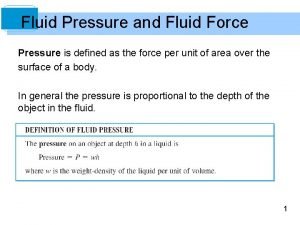Pressure at Depth in a Static Fluid P








- Slides: 8

Pressure at Depth in a Static Fluid P 1 + (1/2) v 12 + gh 1 = P 2 + (1/2) v 22 + gh 2 Notice what Bernoulli’s Equation says about a static fluid: P 1 + gh 1 = P 2 + gh 2 If h 2 > h 1, point 1 is deeper in the fluid than point 2, so: Pdeep = Pshallow + ρ g. Dh Example: At what depth in a freshwater lake would the pressure be equal to twice atmospheric pressure? (1 atm = 1. 01 x 105 Pa, and ρ water = 1000 kg/m 3. ) Hint: Pshallow = 1 atm; Pdeep = 2 atm 2/4/19 OSU PH 212, Before Class #13 1

Tools that Use Effects of Static Fluid Pressure Archimedes’ Principle: ・ All flotation devices Pressure at depth: ・ Pressure gauges ・ Drinking straws and barometers Pascal’s Principle: ・ Hydraulics 2/4/19 OSU PH 212, Before Class #13 2

A swimming pool is filled 10. 0 m deep with pure water. If the atmospheric pressure above a swimming pool then decreases by 1000 Pa, by how much does the pressure decrease on the bottom of the pool? 1. 970 Pa 2. 1000 Pa 3. 1970 Pa 4. 2000 Pa 5. None of the above 2/4/19 OSU PH 212, Before Class #13 3

A swimming pool is filled 10. 0 m deep with pure water. If the atmospheric pressure above a swimming pool then decreases by 1000 Pa, by how much does the pressure decrease on the bottom of the pool? 1. 970 Pa 2. 1000 Pa 3. 1970 Pa 4. 2000 Pa 5. None of the above 2/4/19 OSU PH 212, Before Class #13 4

Pressure Gauges Static pressure varies directly with the depth in an incompressible fluid (no matter the container shape). This makes it very handy to use in a pressure gauge, which measures pressure differences between two points, as indicated by a column of fluid. Most gauges measure pressure against the most convenient reference —atmospheric pressure: Pabs. = Pgauge + Patm. or: P – Pgauge = Patm. (If you don’t see the word “gauge” used, you may assume the pressure indicated is absolute pressure. ) 2/4/19 OSU PH 212, Before Class #13 5

Drinking Straws and Barometers There is no such thing as “suction. ” You cannot effectively move much fluid by “pulling” on it—you can only push on it. When you drink from a straw, you are creating a low-pressure chamber in the straw, so the surrounding atmosphere pushes the liquid up the column. Thus, you can’t drink out of a straw on the moon—or any place where there is no atmospheric pressure. The ultimate example of a drinking straw is the barometer, which indicates atmospheric pressure via a completely evacuated chamber above the fluid column; the pressure in there is essentially zero. Example: What’s the tallest straw that would allow you to sip water through it on earth at sea level? (1 atm = 1. 01 x 105 Pa, and ρ water = 1000 kg/m 3. ) Hint: Pshallow = 0; Pdeep = 1 atm 2/4/19 OSU PH 212, Before Class #13 6

Hydraulics A very powerful tool involving static fluid pressure results from Pascal’s Principle: “If you change the pressure at any point in a trapped container of fluid, that pressure change will occur throughout the entire container—on all of the fluid and the walls of the container. ” 2/4/19 OSU PH 212, Before Class #13 7

The power of Pascal’s Principle becomes apparent when you artificially “press on” a container of liquid. That added pressure instantly transmits to all points in the container. But since pressure is the ratio of force to area, the fluid can thus transmit an enormous output force from a small input force. It all depends on the area over which that force acts. This is how hydraulic systems operate. The same pressure (same depth in a fluid) can allow a small piston pushed by a relatively small force to support a large platform bearing a large load: P 1 = P 2 F 1/A 1 = F 2/A 2 F 2 = F 1(A 2/A 1) Study Figure 14 -16 and Example 14. 7 on pages 368 -369. Then try item 5 a in Prep 4. 2/4/19 OSU PH 212, Before Class #13 8
